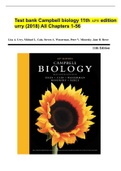Chapter 3 ap biology - Study guides, Class notes & Summaries
Looking for the best study guides, study notes and summaries about Chapter 3 ap biology? On this page you'll find 86 study documents about Chapter 3 ap biology.
Page 3 out of 86 results
Sort by
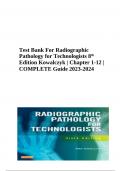
-
Test Bank For Radiographic Pathology for Technologists 8th Edition Kowalczyk Chapter 1-12 | Latest Guide 2023-2024
- Exam (elaborations) • 66 pages • 2023
-
- $28.49
- + learn more
Test Bank For Radiographic Pathology for Technologists 8th Edition Kowalczyk Chapter 1-12 | Latest Guide 2023-2024. Chapter 1: Introduction to Pathology Test Bank MULTIPLE CHOICE 1. The sequence of events producing cellular changes following injury best defines: a. manifestations. b. pathogenesis. c. sign. d. symptom. ANS: B REF: p. 2 2. An abnormal disturbance of the function and structure of the human body following injury refers to: a. disease. b. etiology. c. manifestations. d....
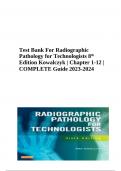
-
Test Bank For Radiographic Pathology for Technologists 8th Edition Kowalczyk | Chapter 1-12 | COMPLETE Guide 2023-2024
- Exam (elaborations) • 66 pages • 2023
-
- $30.49
- + learn more
Test Bank For Radiographic Pathology for Technologists 8th Edition Kowalczyk | Chapter 1-12 | COMPLETE Guide 2023-2024. Chapter 1: Introduction to Pathology Test Bank MULTIPLE CHOICE 1. The sequence of events producing cellular changes following injury best defines: a. manifestations. b. pathogenesis. c. sign. d. symptom. ANS: B REF: p. 2 2. An abnormal disturbance of the function and structure of the human body following injury refers to: a. disease. b. etiology. c. manifestations....
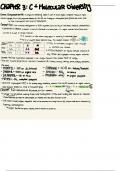
-
Chapter 3 AP Biology Notes
- Book review • 5 pages • 2023
- Available in package deal
-
- $4.99
- + learn more
These are Chapter 3 AP Biology Notes, that are following the AP Biology curriculum. They include all essential ideas, and vocabulary, as well as important visuals to enhance your understanding.
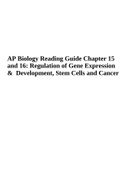
-
AP Biology Reading Guide Chapter 15 and 16: Regulation of Gene Expression & Development, Stem Cells and Cancer
- Exam (elaborations) • 13 pages • 2023
- Available in package deal
-
- $23.49
- + learn more
AP Biology Reading Guide Chapter 15 and 16: Regulation of Gene Expression & Development, Stem Cells and Cancer. What are the two main ways of controlling metabolism in bacterial cells? Feedback inhibition: when the end product of a metabolic pathway goes back and inhibits the one of the enzymes that is active in that pathway. This stops the production of that product. Regulation of gene expression: mechanisms that are used by cells to increase or decrease the production of specific gene pro...
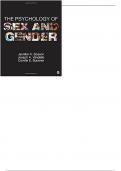
-
The Psychology Of Sex And Gender 1st Edition by Jennifer Katherine - Test Bank
- Exam (elaborations) • 451 pages • 2023
-
- $28.22
- + learn more
Chapter 3: The Nature and Nurture of Sex and Gender Test Bank Multiple Choice 1. As early as 1993, Biologist Ann Fausto-Sterling argued what about biological sex? A. that at least five or more biological sexes should be recognized B. that the cultural tendency to view sex as binary is largely correct C. that there are actually three biological sexes D. that the concept of biological sex is meaningless Ans: A Learning Objective: 3-3: Analyze the biological and sociocultural factors...

-
Test Bank- Campbell Biology 11th Edition By Urry Cain Chapter 1-56 | Complete Guide | 100% Verified Solutions.
- Exam (elaborations) • 928 pages • 2023
-
- $25.49
- + learn more
Test Bank- Campbell Biology 11th Edition By Urry Cain Chapter 1-56 | Complete Guide | 100% Verified Solutions. Chapter 1—Evolution, the Themes of Biology, and Scientific Inquiry MULTIPLE CHOICE 1) Cells are ________. A) only found in pairs, because single cells cannot exist independently B) limited in size to 200 and 500 micrometers in diameter C) characteristic of eukaryotic but not prokaryotic organisms D) characteristic of prokaryotic and eukaryotic organisms ANS: D PTS: 1 TOP: S...
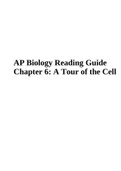
-
AP Biology Reading Guide Chapter 6: A Tour of the Cell
- Exam (elaborations) • 14 pages • 2023
- Available in package deal
-
- $26.49
- + learn more
AP Biology Reading Guide Chapter 6: A Tour of the Cell. To study cells, biologists use microscopes and the tools of biochemistry 1. The study of cells has been limited by their small size, and so they were not seen and described until 1665, when Robert Hooke first looked at dead cells from an oak tree. His contemporary, Anton van Leeuwenhoek, crafted lenses; and with the improvements in optical aids, a new world was opened. Magnification and resolving power limit what can be seen. Explain t...
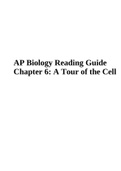
-
AP Biology Exam Guide Chapter 6: A Tour of the Cell
- Exam (elaborations) • 14 pages • 2023
-
- $22.49
- + learn more
AP Biology Reading Guide Chapter 6: A Tour of the Cell. Concept 6.1 To study cells, biologists use microscopes and the tools of biochemistry 1. The study of cells has been limited by their small size, and so they were not seen and described until 1665, when Robert Hooke first looked at dead cells from an oak tree. His contemporary, Anton van Leeuwenhoek, crafted lenses; and with the improvements in optical aids, a new world was opened. Magnification and resolving power limit what can be see...
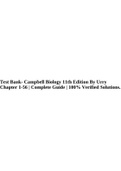
-
Test Bank- Campbell Biology 11th Edition By Urry Cain Chapter 1-56 | Complete Guide | 100% Verified Solutions.
- Exam (elaborations) • 928 pages • 2023
-
- $25.49
- + learn more
Test Bank- Campbell Biology 11th Edition By Urry Cain Chapter 1-56 | Complete Guide | 100% Verified Solutions. Chapter 1—Evolution, the Themes of Biology, and Scientific Inquiry MULTIPLE CHOICE 1) Cells are ________. A) only found in pairs, because single cells cannot exist independently B) limited in size to 200 and 500 micrometers in diameter C) characteristic of eukaryotic but not prokaryotic organisms D) characteristic of prokaryotic and eukaryotic organisms ANS: D PTS: 1 TOP:...

Study stress? For sellers on Stuvia, these are actually golden times. KA-CHING! Earn from your study resources too and start uploading now. Discover all about earning on Stuvia

